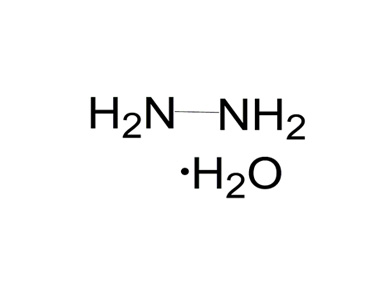HYDRAZINE HYDRATE
CAS NO.: 10217-52-4,7803-57-8
Main Purity: 64% / 68%/ 80% / 100%
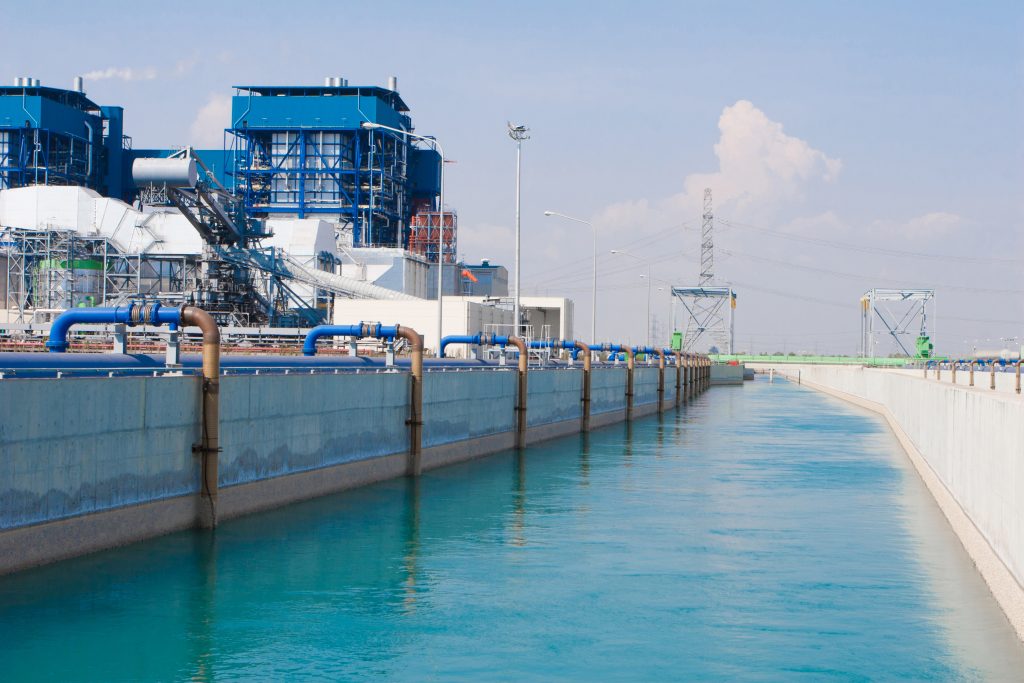
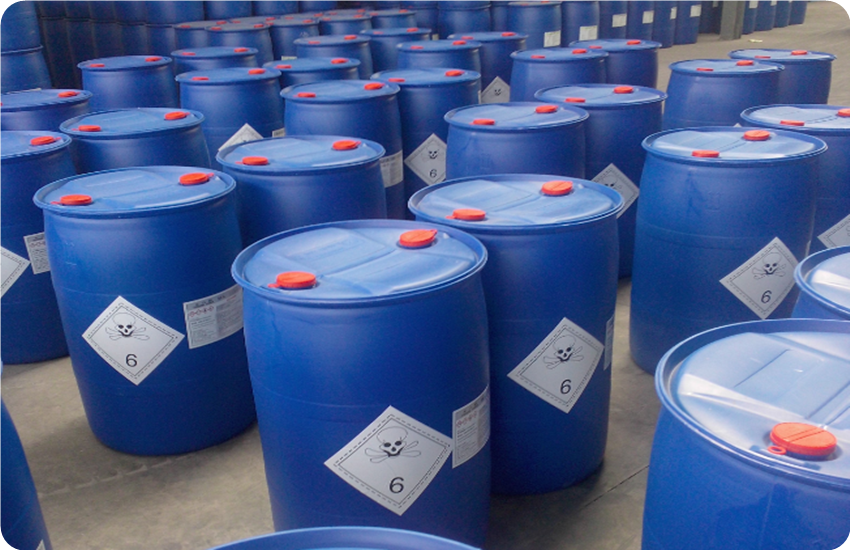
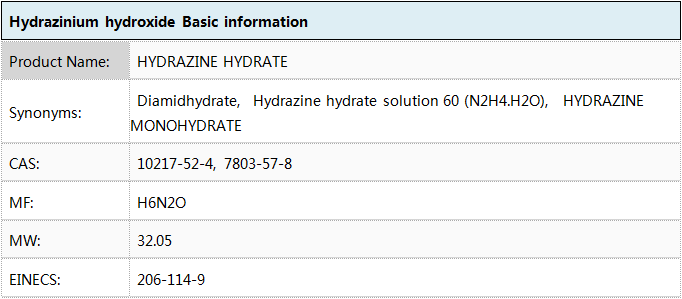
WATER TREATMENT
HYDRAZINE HYDRATE
CAS. 10217-52-4,7803-57-8
Hydrazine hydrate is widely used as a reducing agent or an intermediate of synthesis in various industrial sectors like water treatment (effluents, industrial boilers), chemical treatment process (metals, mine extraction) or active ingredients synthesis (pharmaceuticals and agrochemicals). Desoxidant for boiler descaling, upstream product of Methylhydrazine and many other hydrazine or Pyrazole derivatives.
|
INSPECTION |
SPECIFICATION |
RESULTS |
|
Appearance |
Colorless and clear |
Colorless and clear |
|
Assay % (N2H4•H2O) |
≥64.00 |
64.45 |
|
Non-volatile matter % |
≤0.010 |
0.0080 |
|
Iron % (Fe) |
≤0.0005 |
0.000025 |
|
Sulfate % (SO4) |
≤0.0005 |
<0.0001 |
|
Heavy metals% (Pb) |
≤0.0005 |
<0.0001 |
|
Chloride % (Cl) |
≤0.003 |
<0.00002 |
1.1 Product identifier
Product name:HYDRAZINE HYDRATE 100%
1.2 Relevant identified uses of the substance or mixture and uses advised against
Use of the Substance/Mixture : Pesticide intermediates
1.3 Details of the supplier of the safety data sheet
Company : XI''''''''AN YUANFAR INTERNATIONAL TRADE COMPANY
Address : FL 19, BUILDING B, OAK BLOCK, No. 36 FENGHUI SOUTH RD. XI''''''''AN, CHINA
E-mail address : cynthia@yuanfar.com
SECTION 2. Hazards identification
2.1 Classification of the substance or mixture
2.1.1 Classification according to Regulation (EC) No 1272/2008 (CLP)
Acute Tox. 3 H301
Acute Tox. 3 H311
Acute Tox. 2 H330
Skin Corr. 1B H314
Skin Sens. 1 H317
Carc. 1B H350
Aquatic Acute 1 H400
Aquatic Chronic 1 H410
2.1.2 Additional information:
For full text of Hazard- and EU Hazard-statements: see SECTION 16.
2.2 Label elements

Labelling according to Regulation (EC) No 1272/2008 [CLP] Hazard pictograms
Signal word : Danger
H301 Toxic if swallowed
H311 Toxic in contact with skin
H330 Fatal if inhaled
H314 Causes severe skin burns and eye damage
H317 May cause an allergic skin reaction
H350 May cause cancer
H400 Very toxic to aquatic life
H410 Very toxic to aquatic life with long lasting effects
Precautionary statements:
P264 Wash exposed skin thoroughly after handling.
P270 Do not eat, drink or smoke when using this product.
P280 Wear protective gloves / protective clothing / eye protection / face protection.
P260 Do not breathe dust/fume/gas/mist/vapours/spray.
P271 Use only outdoors or in a well-ventilated area.
P284 [In case of inadequate ventilation] wear respiratory protection.
P261 Avoid breathing dust/fume/gas/mist/ vapours/spray.
P272 Contaminated work clothing should not be allowed out of the workplace.
P201 Obtain special instructions before use.
P202 Do not handle until all safety precautions have been read and understood.
P281 Use personal protective equipment as required.
P273 Avoid release to the environment.
P301 + P310 IF SWALLOWED: Immediately call a POISON CENTER/doctor. P321 Specific treatment (see section 4 on this SDS)
P330 Rinse mouth.
P302 + P352 IF ON SKIN: Wash with plenty of soap and water
P312 Call a POISON CENTER ordoctor/physician if you feel unwell.
P322 Specific measures (see section 4 on this SDS).
P361 Remove/Take off immediately all contaminated clothing.
P363 Wash contaminated clothing before reuse.
P304 + P340 IF INHALED: Remove person to fresh air and keep comfortable for breathing.
P320 Specific treatment is urgent (see section 4 on this SDS) P301 + P330 + P331 IF SWALLOWED: Rinse mouth. Do NOT induce vomiting.
P303 + P361 + P353 IF ON SKIN (or hair): Take off immediately all contaminated clothing. Rinse skin with water [or shower].
P305 + P351 + P338 IF IN EYES: Rinse cautiously with water for several minutes. Remove
contact lenses, if present and easy to do. Continue rinsing.
P333 + P313 If skin irritation or rash occurs: Get medical advice/attention. P308 + P313 IF exposed or concerned: Get medical advice/attention. P391 Collect spillage.
P405 Store locked up.
P403 + P233 Store in a well-ventilated place. Keep container tightly closed.
P501 Dispose of contents/container in accordance with local/regional/national/international regulations
Supplemental Hazard information (EU): Not applicable.
2.3 Other hazards
no information available.
SECTION 3. Composition/information on ingredients
3.1 Substances
Not applicable
3.2 Mixtures

SECTION 4. First aid measures
4.1 Description of first aid measures
General advice : If potential for exposure exists refer to Section 8 for specific personal
protective equipment.
If inhaled : Move person to fresh air; If symptoms persist, consult a physician.
On skin contact : After contact with skin, wash immediately with plenty of water. If
symptoms persist, seek medical advice.
On contact with eyes : If you use contact lenses, remove the lenses first. Wash affected eyes for at least 15 minutes under running water with eyelids held open. Immediate medical attention is required.
On ingestion : Rinse your mouth. Call a physician immediately. Do NOT induce vomiting.
If vomiting occurs, keep head low so that stomach content doesn''''''''''''''''''''''''''''''''''''''''''''''''''''''''''''''''t get into the lungs. Do not use mouth-to-mouth method if victim ingested the substance. Induce artificial respiration with the aid of a pocket mask equipped with a one-way valve or other proper respiratory medical device.
4.2 Most important symptoms and effects, both acute and delayed
Symptoms : Burning pain and severe corrosive skin damage. Convulsions.
Dizziness. Nausea. Causes serious eye damage. Symptoms may include stinging, tearing, redness, swelling, and blurred vision. Permanent eye damage including blindness could result. Irritation of nose and throat. Prolonged exposure may cause chronic effects.
4.3 Indication of any immediate medical attention and special treatment needed
Treatment : Provide general supportive measures and treat symptomatically.
Chemical burns: Flush with water immediately. While flushing, remove clothes which do not adhere to affected area. Call an ambulance. Continue flushing during transport to hospital. Keep victim warm. Keep victim under observation. Symptoms may be delayed.
SECTION 5: Firefighting measures
5.1 Extinguishing media
Suitable extinguishing media : Water fog or fine spray. Dry chemical fire extinguishers. Carbon dioxide fire extinguishers. Foam.
5.2 Special hazards arising from the substance or mixture
Specific hazards during firefighting : During a fire, smoke may contain the original material in addition to combustion products of varying composition which may be toxic and/or irritating. Combustion products may include and are not limited to: Nitrogen oxides.
5.3 Advice for firefighters
Special protective equipment : Wear positive-pressure self-contained breathing apparatus (SCBA) and protective fire fighting clothing (includes fire fighting helmet, coat, trousers, boots, and gloves).If protective equipment is not available or not used, fight fire from a protected location or safe distance.
Further information : No information available.
SECTION 6: Accidental release measures
6.1 Personal precautions, protective equipment and emergency procedures
Personal precautions : Avoid breathing vapor.Avoid skin contact.Use personal protective
equipment.Remove all sources of ignition. Ensure adequate ventilation.
6.2 Environmental precautions
Environmental precautions : Prevent from entering into soil, ditches, sewers, waterways and/or groundwater.
6.3 Methods and materials for containment and cleaning up
Methods for cleaning up : Evacuate personnel to safe areas.Ensure adequate ventilation.Contain spills immediately with inert materials (e.g., sand, earth).Keep in suitable, closed containers for disposal.
6.4 Reference to other sections
References to other sections, if applicable, have been provided in the previous sub-sections.
SECTION 7: Handling and storage
7.1 Precautions for safe handling
Advice on safe handling : Use local exhaust ventilation if there is risk of inhalation vapors, mists or aerosols.Avoid contact with the skin, eyes and clothing.Wear safety glasses with side shields.
Advice on protection against fire and explosion : Sources of ignition should be kept well clear.Grounding device to prevent electrostatic charge buildup.
7.2 Conditions for safe storage, including any incompatibilities
Requirements for storage
areas and containers : Keep tightly closed in a dry and well-ventilated place.Avoid all ignition sources.Ground all metal containers during storage and handling.Avoid temperature extremes during storage; ambient temperature preferred.
7.3 Specific end use(s)
no data available
SECTION 8: Exposure controls/personal protection
8.1 Control parameters
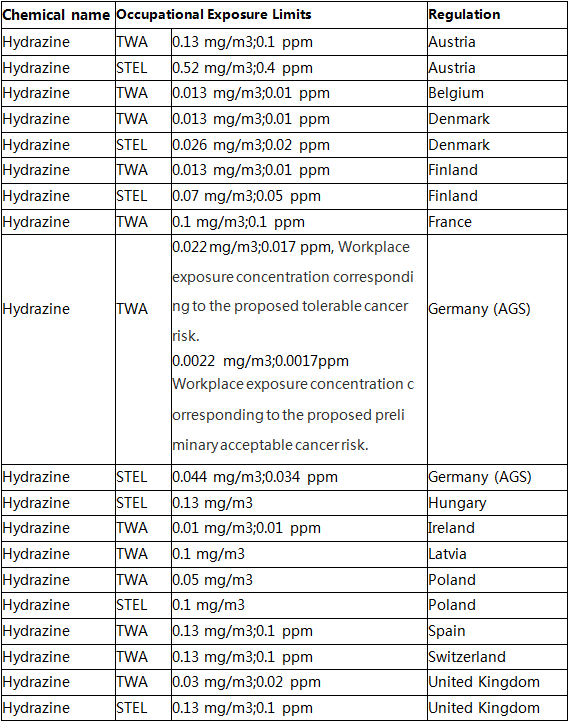
Hand protection : Use gloves chemically resistant to this material.Examples of preferred
glove barrier materials include: Neoprene.
Body and skin protection : Where there is potential for skin contact, have available and wear as
appropriate, impervious gloves, apron, pants, jacket, hood and boots.
General safety and hygiene measures : Wash hands before breaks and after handling the product. Wash contaminated clothing before re-use.
Respiratory protection : None required under normal conditions. Respiratory protection should
be worn when there is a potential to exceed the exposure limit requirements or guidelines.
8.2 Exposure controls
Eye protection : Use safety glasses(with side shields).
SECTION 9: Physical and chemical properties
9.1 Information on basic physical and chemical properties
Appearance: : liquid
Odour : ammonia-like
Odour threshold : no data available
pH : no data available
Melting point : -51.7℃
Boiling point : 120℃
Flash point : >61 ℃
Evaporation rate : no data available Flammability (solid, gas) : not applicable
Upper/lower flammability or explosive limits : no data available
Vapour pressure : no data available Vapour density : no data available
Relative density : 1.1
Water solubility : soluble
Partition coefficient: n- octanol/water : no data available
Auto-ignition temperature : 270°C (glass surface). May be as low as 23°C depending on surface contacted.
Decomposition temperature : no data available
Viscosity, dynamic : no data available
Explosive properties : not explosive
Oxidising properties : not applicable
9.2 Other information :
no data available
SECTION 10: Stability and Reactivity
10.1 Reactivity : No hazardous reactions if stored and handled as prescribed/indicated.
10.2 Chemical stability : This product is chemically stable under standard ambient conditions.
10.3 Possibility of hazardous reactions : Product will not undergo polymerization.
10.4 Conditions to avoid : Avoid all sources of ignition: heat, sparks, open flame. Avoid electro- static charge.
10.5 Incompatible materials : Avoid contact with: Strong acids.Strong oxidizers.
10.6 Hazardous decomposition products : Nitrogen oxides.
SECTION 11: Toxicological information
11.1 Information on toxicological effects Acute toxicity Acute Toxicity: oral
Hydrazine monohydrate LD50/rat:ca. 262 mg/kg bw
Acute Toxicity: inhalation
Hydrazine monohydrate LC50/4 h/rat:570 ppm
Acute Toxicity: dermal
Hydrazine monohydrate LD50/rabbit:91 mg/kg bw
Skin irritation/corrosion
Hydrazine monohydrate rabbit
not irritating
Serious eye damage/irritation
Hydrazine monohydrate rabbit
not irritating
Respiratory or skin sensitisation May cause an allergic skin reaction Germ cell mutagenicity
No information available
Carcinogenicity
May cause cancer Reproductive toxicity No information available STOT-single exposure No information available STOT-repeated
No information available
Aspiration hazard
No information available
SECTION 12: Ecological information
12.1 Toxicity
Short-term toxicity to fish Hydrazine monohydrate
LC50/96 h/Lebistes reticulatus:0.61 mg/L
Short-term toxicity to aquatic invertebrates Hydrazine monohydrate
EC50/48 h/Daphnia pulex:0.19 mg/L
Long-term toxicity to aquatic invertebrates Hydrazine monohydrate
NOEC/21 d/Daphnia magna:0.01 mg/L
Toxicity to microorganisms Hydrazine monohydrate
EC50/3 h/activated sludge of a predominantly domestic sewage:8.6 mg/L
12.2 Persistence and degradability
No data available
12.3 Bioaccumulative potential
No data available
12.4 Mobility in soil
No data available
12.5 Results of PBT and vPvB assessment
No data available
12.6 Other adverse effects
No data available
SECTION 13: Disposal considerations
13.1 Waste treatment methods
Product : Observe national and local legal requirements.
Contaminated packaging : Packs that cannot be cleaned should be disposed of in the same manner as the contents.
SECTION 14: Transport Information
Land transport
ADR
14.1. UN number : 2030
14.2. UN proper shipping : HYDRAZINE,AQUEOUS SOLUTION
name:
14.3. Transport hazard class(es) : 8(6.1)
14.4. Packing group : II
14.5. Environmental hazards
14.6. Special precautions for user : marine pollutant
: none
Sea transport
IMDG
14.1. UN number : 2030
14.2. UN proper shipping : HYDRAZINE,AQUEOUS SOLUTION
name:
14.3. Transport hazard class(es) : 8(6.1)
14.4. Packing group : II
14.5. Environmental hazards
14.6. Special precautions for user : marine pollutant
: none
Air transport
IATA/ICAO
14.1. UN number : 2030
14.2. UN proper shipping : HYDRAZINE,AQUEOUS SOLUTION
name:
14.3. Transport hazard class(es) : 8(6.1)
14.4. Packing group : II
14.5. Environmental hazards
14.6. Special precautions for user : marine pollutant
: none
14.7. Transport in bulk according to Annex II of MARPOL 73/78 and the IBC Code
Not applicable
SECTION 15: Regulatory information
15.1 Safety, health and environmental regulations/legislation specific for the substance or mixture
Other regulations : Take note of Directive 98/24/EC on the protection of the health and safety of workers from the risks related to chemical agents at work.
15.2 Chemical Safety Assessment
A Chemical Safety Assessment/Chemical Safety Report may not be required because: substance(s) are exempted from being registered under REACH, are not yet registered under REACH, are registered under another regulatory process (biocide uses, plant protection products), the volume is below the 10 tons/year threshold specified under Art.14(1) of REACH, the concentration of substance(s) in a mixture is/are below the limits specified under Art. 14(2) of REACH.
SECTION 16: Other information
Full text of H-Statements referred to under section 3.
H301 Toxic if swallowed
H311 Toxic in contact with skin
H330 Fatal if inhaled
H314 Causes severe skin burns and eye damage
H317 May cause an allergic skin reaction
H350 May cause cancer
H400 Very toxic to aquatic life
H410 Very toxic to aquatic life with long lasting effects
Abbreviations and acronyms
ADR European Agreement concerning the International Carriage of Dangerous Goods by Road
ATE Acute toxicity estimate
CAS-No. Chemical Abstracts Service number
CLP Classification, Labelling and Packaging
EbC50 Concentration at which 50% reduction of biomass is observed
EC50 Median effective concentration
EN European Norm
EPA Environmental Protection Agency
ErC50 Concentration at which a 50% inhibition of growth rate is observed
EyC50 Concentration at which 50 % inhibition of yield is observed
IATA_C International Air Transport Association (Cargo)
IBC International Bulk Chemical Code
ICAO International Civil Aviation Organization
ISO International Standard Organization
IMDG International Maritime Dangerous Goods
LC50 Median Lethal Concentration
LD50 Median Lethal Dose
LOEC Lowest Observed Effect Concentration
LOEL Lowest observed effect level
MARPOL International Convention for the Prevention of Marine Pollution from
n.o.s. Not Otherwise Specified
NOAEC No Observed Adverse Effect Concentration
NOAEL No observed adverse effect level
NOEC No Observed Effect Concentration
NOEL No Observed Effect Level
OECD Organisation for Economic Co-operation and Development
OPPTS Office of Prevention, Pesticides and Toxic Substances
PBT Persistent, Bioaccumulative and Toxic
STEL Short term exposure limit
TWA Time Weighted Average (TWA)
vPvB very Persistent and very Bioaccumulative
The information herein is provided in good faith and believed to be accurate as of the effective date shown above. However, no warranty, express or implied, is given. Regulatory requirements are subject to change and may differ between various locations. It is the buyer''''''''''''''''''''''''''''''''''''''''''''''''''''''''''''''''s/user''''''''''''''''''''''''''''''''''''''''''''''''''''''''''''''''s responsibility to ensure that his activities comply with all federal, state, provincial or local laws. The information presented here pertains only to the product as shipped. Since conditions for use of the product are not under the control of the manufacturer, it is the buyer''''''''''''''''''''''''''''''''''''''''''''''''''''''''''''''''s/user''''''''''''''''''''''''''''''''''''''''''''''''''''''''''''''''s duty to determine the conditions necessary for the safe use of this product. Due to the proliferation of sources for information such as manufacturer specific SDSs, we are not and cannot be responsible for SDSs obtained from any source other than ourselves. If you have obtained an SDS from another source or if you are not sure that the SDS you have is current, please contact us for the most current version.
Hydrazine hydrate is widely used as a reducing agent or an intermediate of synthesis in various industrial sectors like water treatment (effluents, industrial boilers), chemical treatment process (metals, mine extraction) or active ingredients synthesis (pharmaceuticals and agrochemicals).
Hydrazine hydrate is marketed as a water-based solution at different hydrazine concentration.
Desoxidant for boiler descaling, upstream product of Methylhydrazine, good reductant in electroplating, insect growth regulator.

